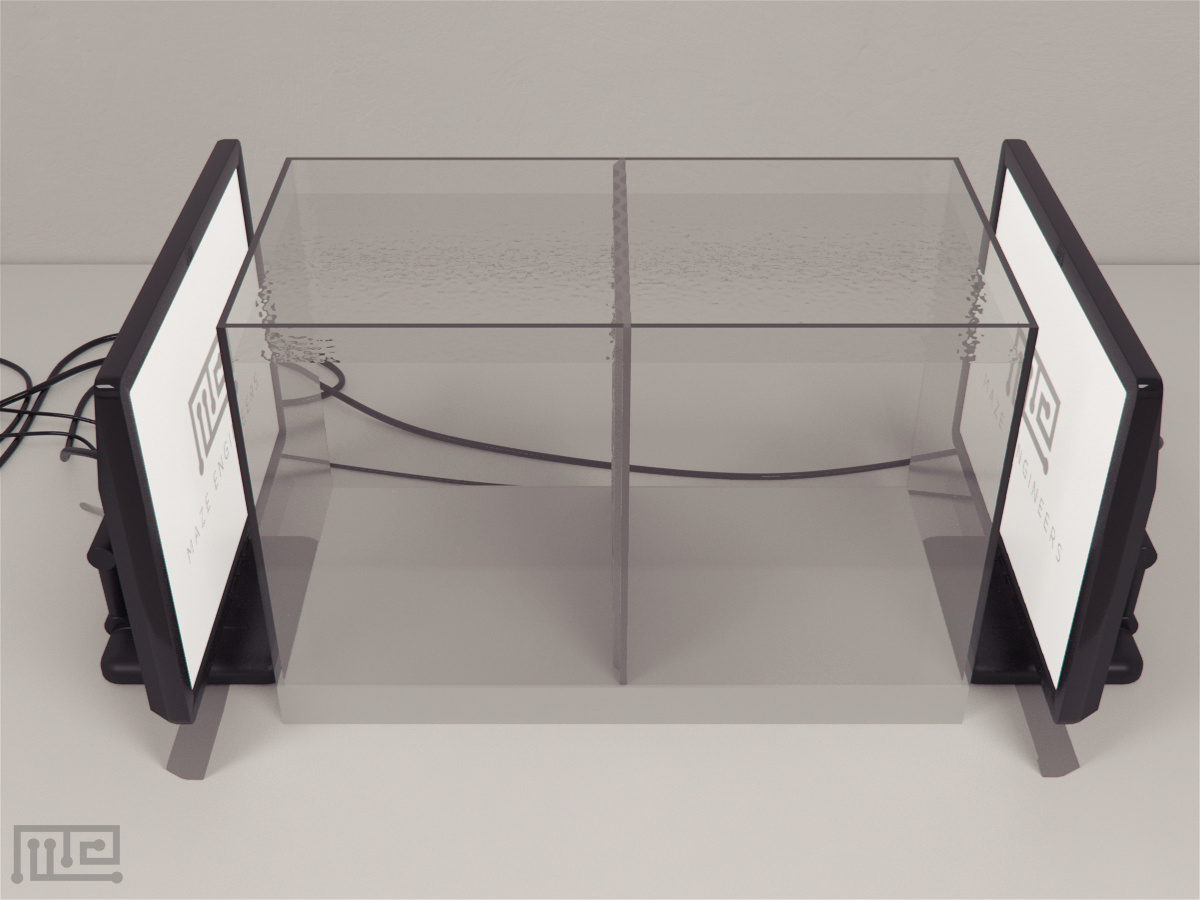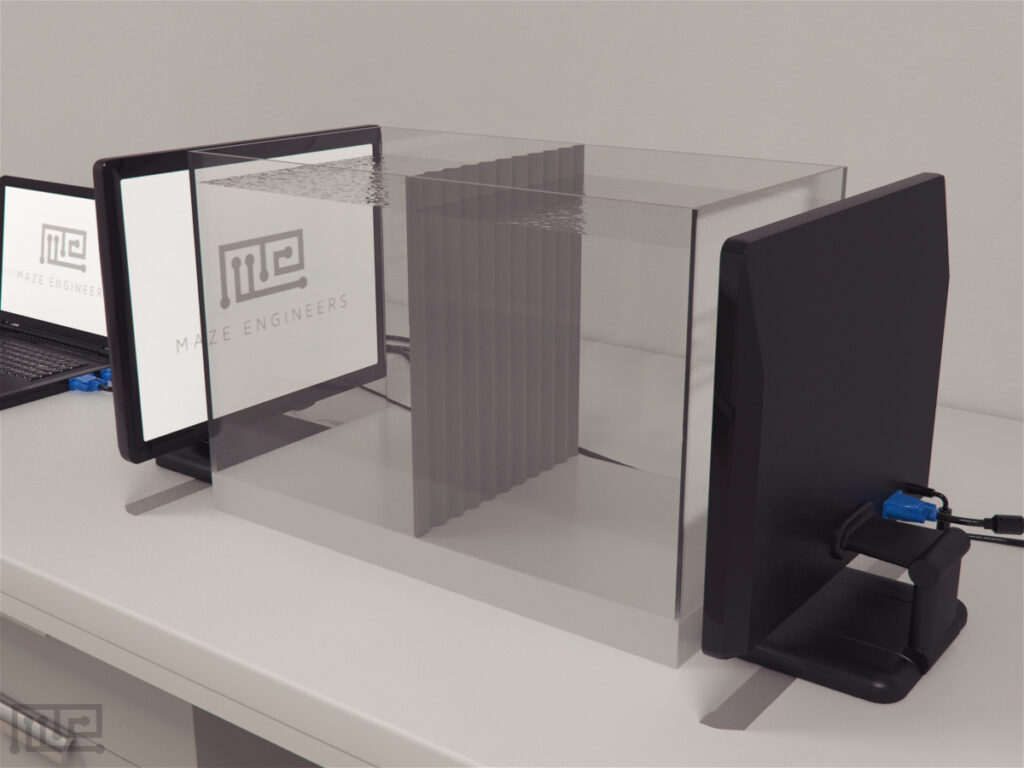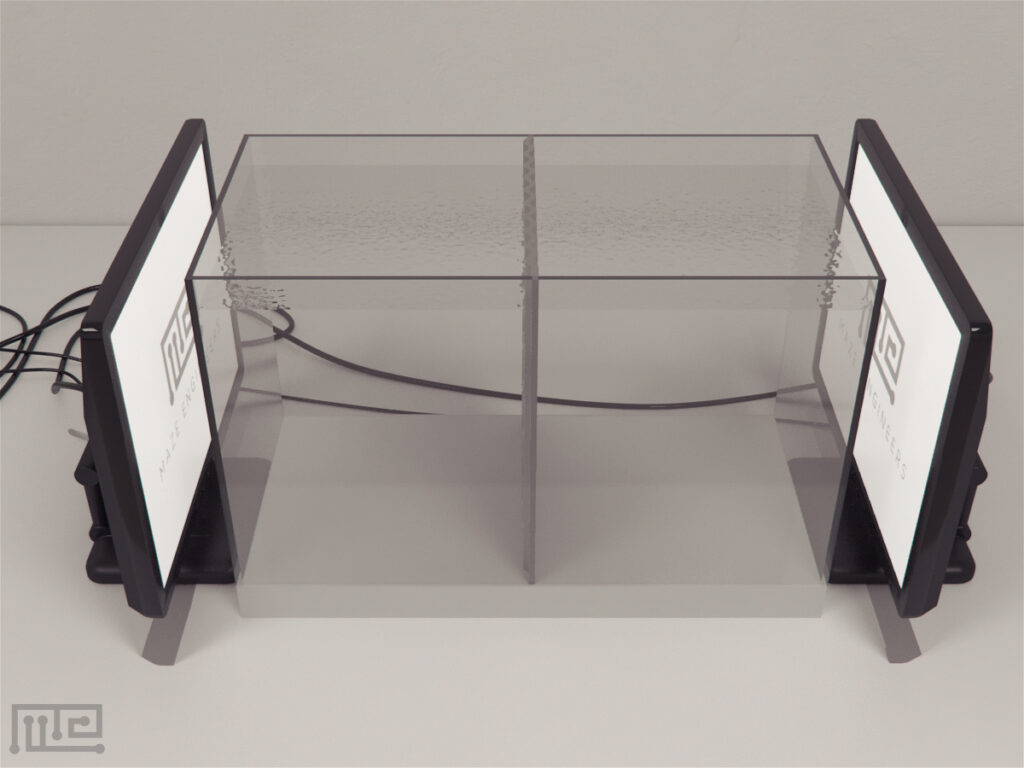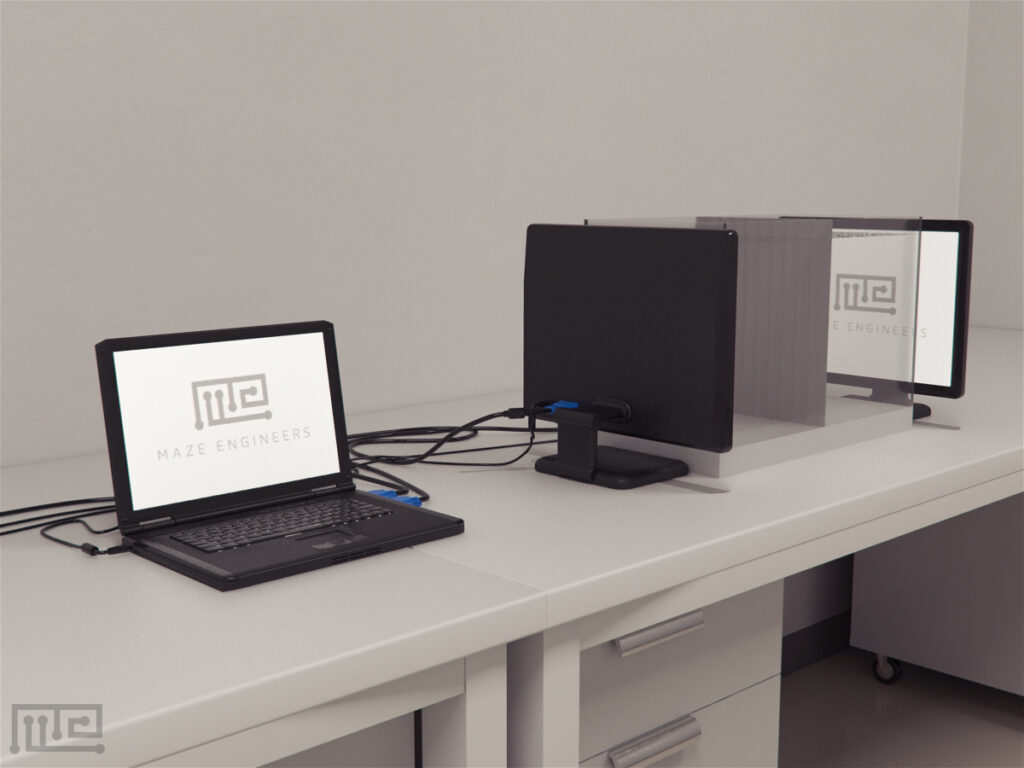Description
The Zebrafish Shuttlebox presents an automated method for high throughput learning paradigm testing. In this protocol, two screens are used from an automated computer screen to create computer animated zebrafish images, or any image in which the researcher specifies. This simple paradigm between binary choices makes this a useful high throughput assay for zebrafish.
Price & Dimensions
Zebrafish Shuttle Box
$ 4990
+SH- 38 L experimental tank (50 × 25 × 30cm, width × depth × height)
- 2.5 cm thin, grey, corrugated, plastic frame mounted to midline, side, and bottom of glass to minimize contact with video side of glass
- Price includes two monitors
Documentation
Introduction
The Zebrafish Shuttle Box task is used to evaluate the cognitive abilities of zebrafish. The task uses a tank set-up with two digital screens on either end to analyze associative learning, temporal learning and social behaviors of the subjects when presented with visual cues.
Zebrafish animal models have gained popularity over the years due to their genetic similarity with humans and ease of maintenance. Further, Zebrafish are highly social and prefer shoaling. The Zebrafish Shuttle Box is based on this social nature of the fish. An individual subject is most likely to approach an animated visual presentation of a conspecific group and spend time around it. The use of conspecifics as visual stimuli has been shown to have reinforcing properties, making it suitable for use in associative learning tasks (Al-Imari, & Gerlai, 2008). The presentation of visual stimuli on digital screens allows experimenters flexibility of spatial and temporal control over stimuli parameters. This also eliminates the use of live conspecifics as visual stimuli.
Other Zebrafish based apparatuses include the Zebrafish Y-maze, the Zebrafish Three Chamber Choice, and the Zebrafish Place Preference Test.
Apparatus & Equipment
The Shuttle Box is a glass tank with a capacity of 38 liters. The width, depth, and height of the Shuttle Box are 50 cm, 25 cm, and 30 cm, respectively. A thin corrugated plastic frame, 2.5 cm wide, is mounted on to the sides and the bottom glass on the inside of the experimental tank in the center of the tank. Monitors are placed on the outside surface of the tank on two opposite sides.
Training Protocol
Keep zebrafish in tanks with constant temperature and pH value. Maintain consistent environmental conditions during housing and testing to avoid unnecessary harm and stress to the subject. Aerate the water to ensure that the quality of the water is always maintained at an acceptable level. Clean the tank before conducting the test. Tracking and recording of behaviors of the fish can be done with the help of a tracking system such as Noldus Ethovision XT. No habituation or pretraining is required for the Zebrafish Shuttle Box task.
Animated stimulus presentation task
Transfer the subject from its holding tank into the Shuttle Box. For the initial 10 minutes, display a black screen on both tank screens. Follow this by displaying the animated stimulus on one side of the tank (chosen at random) for the next 10 minutes. Finally, display a black screen for 2 minutes. Change the side at which the stimulus is displayed randomly for each experimental subject.
Learning associative tasks
Transfer the subject from its holding tank into the Shuttle Box. Display the animated stimulus on one of the screens for 20 seconds (Stimulus presentation interval). Follow this by a 90-seconds inter-stimulus interval (ISI) where no stimulus is displayed. Repeat stimulus presentation followed by inter-stimulus interval at least 30 times. The stimulus can be displayed on alternating sides, same side or randomly as required by the investigation.
Evaluation of responses of Zebrafish in Shuttle Box tasks
Pather and Gerlai (2009) evaluated the performances of zebrafish of the AB strain in the animated stimulus presentation task and the associative learning tasks in the Shuttle Box. Images of 6 female zebrafish moving in random directions, at variable speeds were used as stimuli. They gauged that the response to animated stimulus presentation task and learning associative tasks were similar. The fish moved closer to the screen during stimulus presentation interval and swam away when the stimuli were removed. It was observed that there was an increase in swimming during the inter-stimulus interval (ISI). This could be due to the exploratory behavior of the fish engendered by the removal of the fish stimulus. In addition to this, it was seen that there was a significant increase in the thrashing in the wall adjacent to where the stimuli were displayed. This form of shoaling response was significantly reduced during ISI.
Data Analysis
The following parameters can be observed using the Zebrafish Shuttle Box.
- Percentage of time spent on the side where the stimulus was presented.
- Percentage of time swimming.
- Percentage of time thrashing.
- Motor movement pattern.
- Posture movement pattern.
- Differential fear
- Distance of the fish from the screen where the image appears.
Strengths & Limitations
Strengths
The Zebrafish Shuttle Box task is used to assess learning, memory and developmental alterations of zebrafish. The task has the potential for high throughput screening due to being computerized and straightforward. As the stimuli are digitally displayed, the researchers have complete spatial and temporal control over the stimulus delivery, thus enhancing the task’s precision. The task can be extended to evaluate different aspects of learning by using different visuals, such as fear-based learning using an aversive visual stimulus. The Shuttle Box can be used to evaluate the effects of brain lesion, pharmacological manipulations, and diseases and disorders.
Limitations
Along with video tracking, manual observations may be needed to discern between different types of movements. Extraneous cues can cause the fish to freeze during the experiment, leading to anomalous results. The length of the Shuttle Box may be a factor in judging whether the Zebrafish decided to change sides in anticipation of the stimulus or if they just wanted to be near shoal. The visual used may also be a contributing factor to the subject’s task performances. Images of atypical or abnormal conspecifics may be either ignored or avoided.
Summary & Key Points
- The Zebrafish Shuttle Box task is used in the evaluation of learning, memory and development alterations in Zebrafish.
- The Zebrafish Shuttle Box task is automated and provides researchers spatial and temporal control over the stimulus delivery.
- Manual observations may be needed to discern between different types of movement of zebrafish.
- Responses of the zebrafish are influenced by the visual stimuli. Presentation of images of conspecifics with atypical or abnormal features may not elicit the expected shoaling behaviors.
- The length of the test tank must be considered when deriving conclusions from the data.
- Extraneous cues can distract the subjects and hamper the results.
References
Al-Imari, L., & Gerlai, R. (2008). Sight of conspecifics as reward in associative learning in zebrafish (Danio rerio). Behavioral Brain Research, 189:216–9
Pather, S., & Gerlai, R., (2009) Shuttle box learning in zebrafish (Danio rerio). Behav Brain Res, 196(2), pp.323-7




